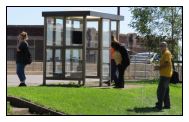We’re working to line up funding for Duluth-Area projects in 2021
Federally-funded transportation projects can be big, expensive, and time-sensitive — which means they need to be planned in advance. In fact, we’re working now to line up funding for Duluth-area projects in 2021.
The following projects have been proposed by eligible Duluth-area jurisdictions for construction in the year 2021. They will be submitted for review and approval by the MIC Policy Board and the Northeast MN Area Transportation Partnership for inclusion in the Draft 2018-2021 TIP, and we are seeking public input or comment by March 15:
Project: Bridge improvements at junction of State Highway 35 and 27th Ave W. in Duluth
Jurisdiction: MnDOT
Project Cost: $2,100,000 million ($1,890,000 federal, $210,000 state funds)
Project: Culvert Improvements at US Steel Creek in Duluth
Jurisdiction: MnDOT
Project Cost: $1,100,000 ($1,100,000 state funds)
Project: Culvert improvements at Gogebic Creek in Duluth
Jurisdiction: MnDOT
Project Cost: $1,100,000 ($1,100,000 state funds)
Project: I-35 Drainage System improvement at Lakewalk in Duluth
Jurisdiction: MnDOT
Project Cost: $1,100,000 ($1,100,000 state funds)
Project: Upgrade fiber optic cable and traffic cameras in Duluth
Jurisdiction: MnDOT
Project Cost: $425,000 ($382,500 federal, $42,500 state funds)
Project: Resurface Lismore Road, 5.5 miles from North Tischer Road to Ryan Road
Jurisdiction: St. Louis County
Project Cost: $3,143,825 ($1,285,000 federal, $1,858,825 local funds)
Project: Resurface roadway, storm sewer, curb and gutter repairs and sidewalks along Railroad Street from Garfield Ave to 5th Ave W.
Jurisdiction: City of Duluth
Project Cost: $992,788 ($742,936 federal, $249,852 state funds)
Project: Resurface roadway, storm sewer, curb and gutter repairs and sidewalks along Railroad Street from 5th Ave W to Canal Park Drive
Jurisdiction: City of Duluth
Project Cost: $724,362 ($542,064 federal, $182,298 state funds)
Project: Duluth Dial-A-Ride Transit Operating Assistance
Jurisdiction: Duluth Transit Authority
Project Cost: $1,400,000 ($1,400,000 local funds)
Project: Duluth Operating Assistance – Regular Route
Jurisdiction: Duluth Transit Authority
Project Cost: $14,040,000 ($1,000,000 federal, $13,040,000 local funds)
Project: Rehab/Renovation of Transit Terminals and Shelters
Jurisdiction: Duluth Transit Authority
Project Cost: $50,000 ($40,000 federal, $10,000 local funds)
Project: Transit Signal Priority (TSP) System Improvements
Jurisdiction: Duluth Transit Authority
Project Cost: $150,000 ($120,000 federal, $30,000 local funds)
Project: Intelligent Transportation System (ITS) Improvements
Jurisdiction: Duluth Transit Authority
Project Cost: $100,000 ($80,000 federal, $20,000 local funds)
Project: Support and Facilities Equipment Purchase
Jurisdiction: Duluth Transit Authority
Project Cost: $690,000 ($552,000 federal, $138,000 local funds)
Project: Purchase Nine Standard 40-ft. Replacement Buses
Jurisdiction: Duluth Transit Authority
Project Cost: $4,695,000 ($3,756,000 federal, $939,000 local funds)
Project: Facility Rehabilitation
Jurisdiction: Duluth Transit Authority
Project Cost: $400,000 ($320,000 federal, $80,000 local funds)
We want to know what you think!
Do these projects meet our area’s transportation needs, and make good use of our limited federal, state and local funds? Do you have any other comments or questions?
Call Chris Belden at (218) 529-7502
OR – Send Chris an email
OR- Stop in and talk in person at the ARDC/MIC office in downtown Duluth at 221 West First Street (skywalk level)






